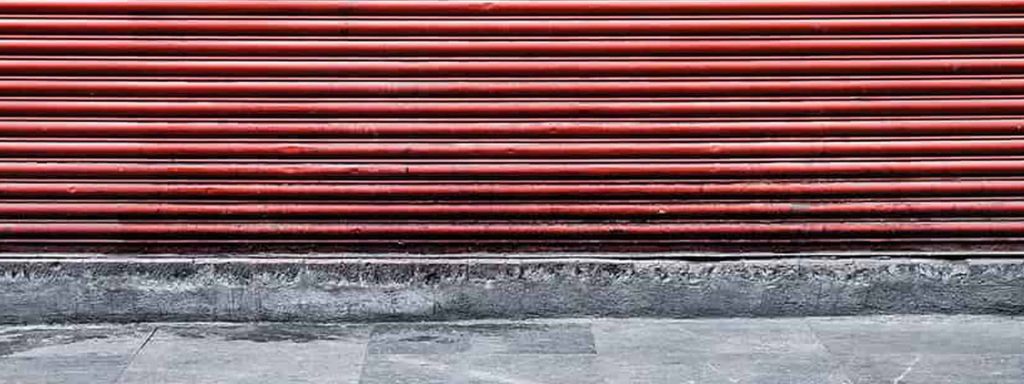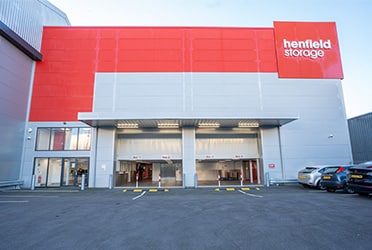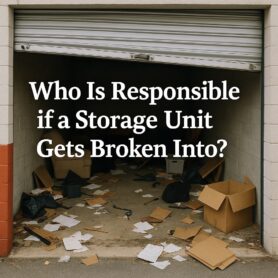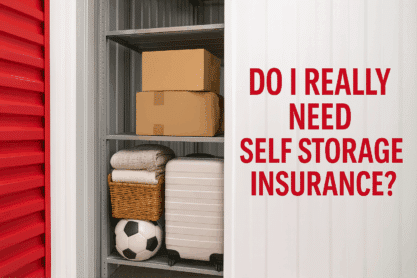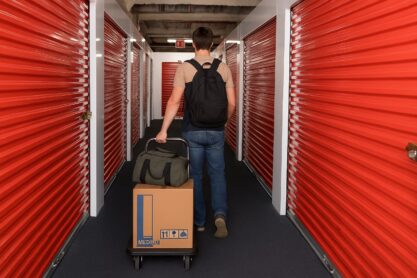When it comes to storing bulky items or furniture, selecting an appropriately sized unit is essential. Too small, and you risk cramming, which can lead to damage; too large, and you’re paying for unnecessary space. Start by listing all the items you plan to store and consult the site manager to find a unit that fits. Henfield Storage offers a range of storage units across London, from 10×10 sq ft to 200×200 sq ft, so you can find the perfect fit, whether you’re storing a few boxes or entire room sets.
To help you maximise your storage space, here are some expert tips for arranging your items efficiently, from placing frequently used items at the front to using shelves and vertical stacking. These strategies will ensure that your storage unit remains accessible and organised, allowing you to retrieve your belongings whenever you need them. Read on for our top tips to get the most out of your storage unit!
Tip #1: Store Your Most-Used Items At The Front
Although storage units can be highly convenient, you need to pack them in the right way to get the most out of them.
First thing’s first: pack your most-used items at the front. Doing so will prevent you from having to regularly pull out all your things to get to the stuff that you want – a major hassle.
It’s also a good idea to keep to a list of the items that you think you’ll use the most often so that you can actively plan what should go where.
Tip #2: Use Shelving
Although shelving takes up space in your unit, it helps to create additional space overall, especially in the vertical direction. Packing a self-storage unit shouldn’t be about cramming as much stuff into a volume as possible and then hoping for the best. You want to be able to retrieve your possessions in good condition conveniently. You don’t want them damaged by other items weighing down on them from above.
Simply piling one thing on top of another is likely to lead to damage, crushed boxes and scratched up furniture. That’s why many people install shelving. Shelving helps you make the most of the vertical space in your storage unit while at the same time reducing the risk of damage.
Shelving makes sense when you have a lot of smaller items that you want to access quickly. With an organised shelving system, you can quickly find the things you need without having to spend time rummaging through boxes and creating a mess.
Tip #3: Start On The Outside And Work Inwards
When approaching any storage space, you want to maximise the volume that you have for your possessions while at the same time making sure that they remain accessible. It’s good practice, therefore, to begin by lining the edge of your storage unit with shelving, boxes, or anything else that you need to store. By lining the outside of your storage space, you ensure that you retain instant access to everything.
If you have a lot of stuff or a small space, then you may find that you begin to fill the interior. At this point, start creating aisles. Aisles will allow you to use the interior of the space without compromising access. Make sure you leave a space between the items around the edge and those in the middle so that you can access both, should you require.
tip #4: Break It Down
Remember that the majority of your valuables, especially the big things, break down into smaller parts. Take the coffee table from Ikea for instance or the bathroom vanity mirror. With an instruction manual and a couple of handy tools, you can easily deconstruct them and pack them away in boxes. Rather than a huge sofa in the corner of the unit taking up room, you’ll have small, flexible packages which are excellent for stacking.
Tip #5: use your vertical space (Pack Bulky Items Vertically!!)
As soon as you open the padlock and lift the door, you’ll see the floor space. It’s tempting to focus only on the bottom of a storage unit rather than the room as a whole. It isn’t as if you can hang anything from the walls or ceiling, so there’s no point, according to the majority of renters.
However, we disagree because a storage unit is a three-dimensional space with height and volume. So, stacking boxes on top of one another is a fantastic way to utilise the length of the unit as well as the width. Just be sure to think carefully about which things you put up high in case they fall and break.
If you’re planning on storing large items like bed frames, mattresses, or furniture, then ensure that you store them vertically. The reason for this is simple: storing these items vertically will maximise the use of vertical space, leaving more room for the rest of your possessions. Many large items are natural candidates for vertical storage, especially things like mattresses and bed frames. Orientating them vertically saves room for items that require more horizontal space.
We recognise that using the height of the unit as well as the width brings a few risks, mainly instability. It isn’t uncommon for things to move over time and fall as a result. Because these things are valuable to you, the last thing you want to discover is a broken mess on the floor upon your return.
Thankfully, a humble piece of plywood is on hand to help. For starters, it adds stability to the layers as you stack them higher and higher. Secondly, it takes the pressure off the boxes and stops them from collapsing into one another. Let’s face it – cardboard isn’t famous for its strength. Alternatively, you can store the heavy things on the bottom.
This should allow you to stack things high and use as much space as possible, getting the most out of your unit in the process.
Tip #6: Make Use Of Drawers
If you are planning on storing things like pine dressers and chests of drawers, then use the drawers to store smaller items. If possible, label drawers so you know what’s inside, and store like items with like.
Tip #7: treat it like tetris
If you want to pack more into your storage boxes or units, we reveal the tricks to becoming a Tetris expert. Apply them in real life and fit more into your storage space!
Think big not small
Many people think Tetris is all about clearing one line at a time. The experts look beyond that. They look at how they can clear 4 lines at once. It’s a long-term tactic but it clears the lines faster than working 1 line at a time.
When it comes to packing, many people start packing as they go, fitting in things where they can, i.e. the 1 line approach. But if you want to make the most of your space you need to look at the big picture. How would your items work best together overall?
Yes it will take more time to figure out, but you’ll have packed more effectively in the long run.
Experiment with lots of different angles
Just because you cleared the level or packed everything in the first time, doesn’t mean it was the most effective way. The key to mastering any skill is repetition, which means repacking! We can appreciate that you won’t want to repack — but if you’re trying to make space, it’s a necessary evil.
Stack multi-player
While practice does make perfect, experts are well aware that they can learn different tricks from one another. Playing multi-player (or packing together) can show you new ways of stacking and packing that you might not have been aware of.
Tip #8: Be Seasonal
Many businesses rely on seasonal promotions or advertising. Therefore, they need somewhere to store promotional materials until the appropriate time of year arrives again. Retailers, for instance, don’t need Christmas signage all year round and can, therefore, benefit from self-storage to keep these items safe until the following seasons.
Private customers can benefit too. Rather than storing all their Christmas decorations in a cupboard, taking up space, self-storage allows them to get it out of the house until the time comes to use it again.
Rotating your storage by seasonal usage can, therefore, help to maximise your use of space. If you think you need one, book a London self storage with us now.
Tip #9: Wrap It Up
One thing we don’t provide is a cleaning service. Once the goods are in the unit, it’s up to the customer to take care of their storage space. That way, there is added security and no pesky interfering from the company.
Not to say you’re one of these people, but some shoppers are lazy. As soon as the items are in storage, they forget about them and leave them for months on end. When they finally collect them, their valuables are dusty and need cleaning.
Wrapping your goods in cling film is an incredible way to stop the dust from building up so that they look brand new even after a year in storage. Anyway, wouldn’t you rather use this hack than turn up with a feather duster once a week?!
tip #10: Label Everything
This is a big one in our eyes because we see the panic in our customers’ eyes a lot. “Oh God,” they think, “where did I put it?!” Of course, they can’t remember due to the fact they packed the storage unit a long time ago and their brain is a touch hazy. So, they have to remove every item from every box and repack them all again once they’re finished.
It’s a lot of hassle and something which is easily avoidable if you label the boxes. There’s no need to tag individual belongings because the boxes themselves will suffice. Write down things such as “kitchenware” or “antiques” or anything that jogs your memory.
Then, when you come to search the storage unit in the future, you won’t have to use your detective skills to find an item.
tip #11: Create A Layout Of Your Storage Space
Having a plan of where everything will go can be useful for both businesses and private customers. With a plan, you can quickly determine where you put particular items, enabling you to find them quickly when you come to retrieve them.
tip #12: Purge It
We are happy to house as many of your belongings as we can fit into our storage units. However, we understand renting a plethora of rooms is a cost the average person can’t afford. With that in mind, it’s essential to ask a simple question: “Do I really need this?”
It’s easy to keep hold of things for old time’s sake or just in case, even if you’re never likely to use them again. The problem with this is that it takes up space in your storage unit and makes it tricky to find a place for everything.
A purge is a fantastic way to house the essentials, and you can start by selling or donating them to charity.
Areas Henfield Storage Serves
Henfield Storage proudly offers convenient and secure storage solutions across a wide range of locations. We serve areas throughout London, Sussex, and Brighton, ensuring reliable coverage for your storage needs.
Due to our wide coverage, we can serve areas like:
With competitive pricing, flexible rental options, and free collection services for long-term bookings, Henfield Storage is here to help you make space where it matters. Contact us today for a free quote or to learn more about our services!

